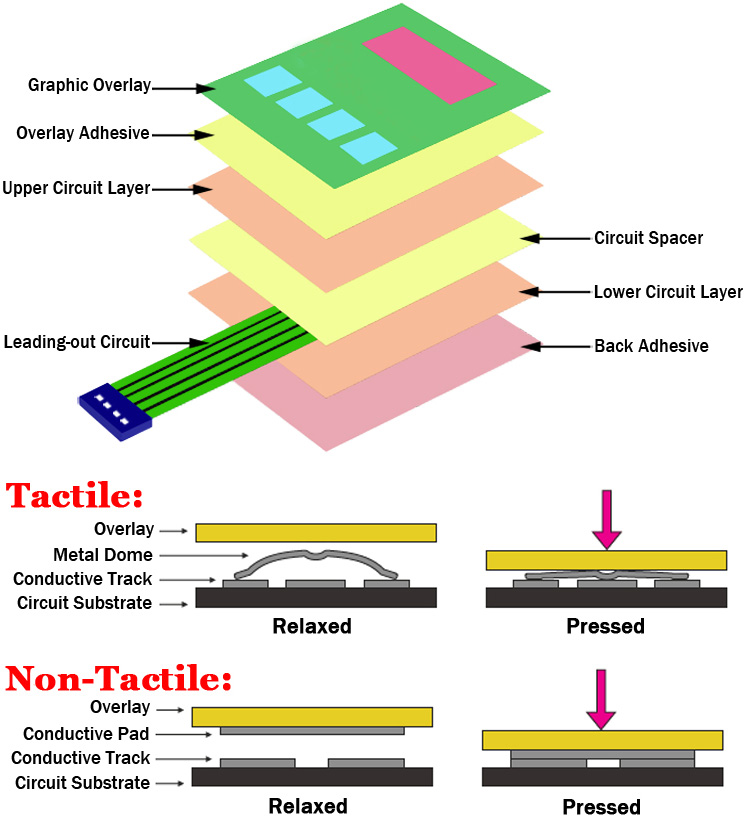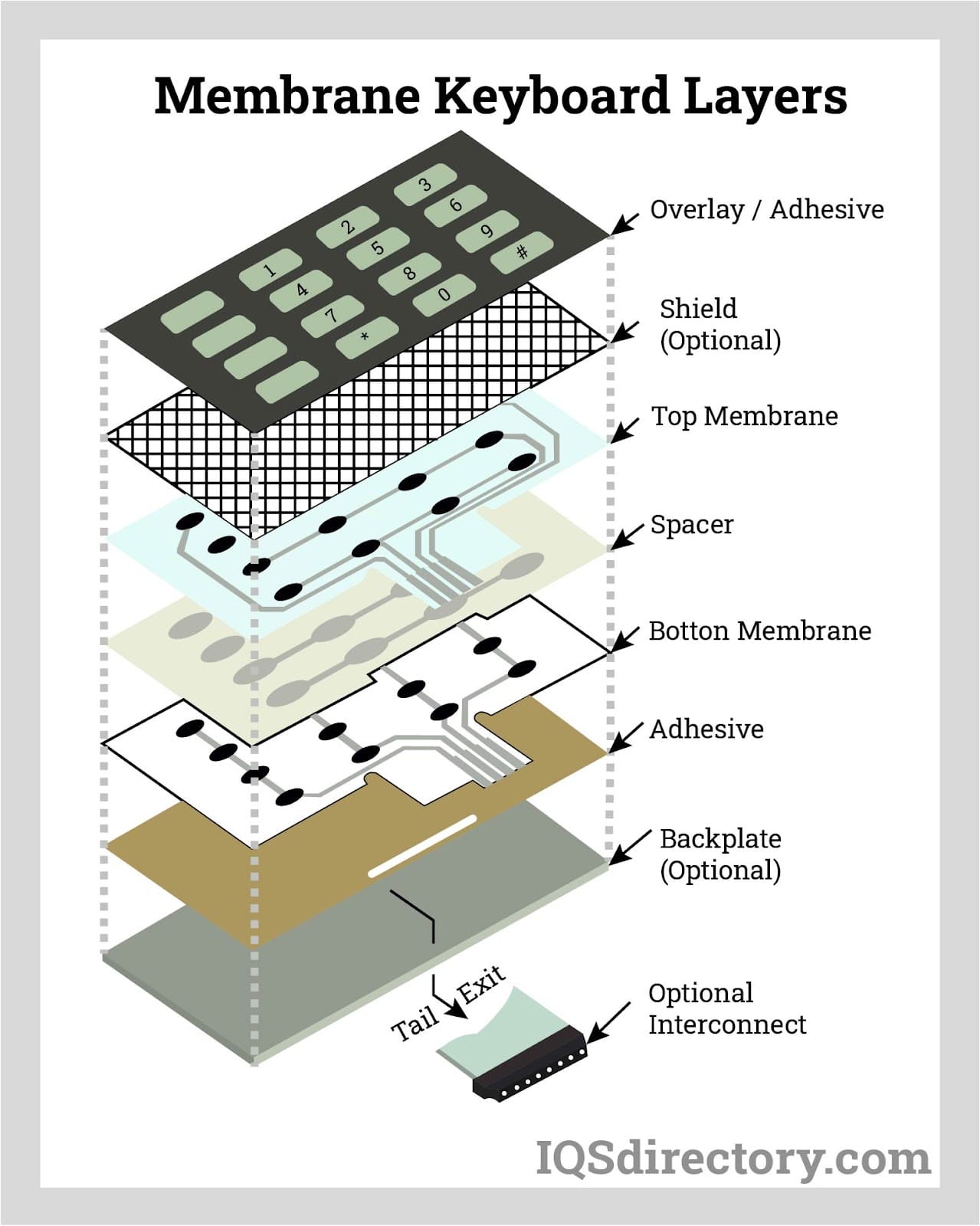Recognizing the Significance of Membrane Switch Over in Modern Electronic Devices
Membrane buttons are indispensable elements in modern electronic tools. They provide a mix of performance and style that enhances individual communication. Their lightweight and sturdy nature makes them appropriate for numerous applications. As industries advance, the demand for modification and advanced functions expands. Recognizing how membrane layer switches add to innovation exposes their significance fit the future of electronic devices. What lies ahead for this innovation?
The Essentials of Membrane Layer Switch Over Technology
Often ignored, membrane layer button innovation plays an important role in the modern-day electronics landscape. These tools, composed of several layers, work as individual interfaces for different digital items, ranging from household appliances to medical equipment. A typical membrane switch includes a graphic overlay, a spacer layer, and a circuit layer, which are carefully put together to produce a practical interface.When pressure is applied to the overlay, the circuit layer is finished, permitting signals to be sent to the tool. This innovation is understood for its adaptability, making it possible for personalization in layout, form, and performance to fulfill certain individual demands. Furthermore, membrane buttons are slim and light-weight, making them ideal for applications where space is a premium. Their resilience and resistance to environmental variables additionally improve their appeal, guaranteeing they can endure harsh problems while maintaining performance. In general, membrane layer switch innovation is integral to producing efficient and straightforward electronic gadgets

Trick Benefits of Membrane Layer Switches
Membrane changes deal numerous key advantages that make them a favored selection in various digital applications. Their design enables a portable type variable, making it possible for suppliers to produce lightweight and smooth gadgets. In addition, membrane layer buttons are immune to dirt, dampness, and chemicals, which boosts their longevity and longevity in requiring environments. The tactile responses provided by these buttons can improve customer experience, making them very easy and user-friendly to operate.Furthermore, membrane layer switches can be personalized with varied graphics and shades, permitting one-of-a-kind branding opportunities. The manufacturing process is normally economical, especially for high-volume manufacturing, as it decreases setting up time and streamlines style. Ultimately, membrane switches over require minimal upkeep, contributing to reduced overall operational expenses. These advantages underscore their growing popularity in contemporary electronics, where integrity and user-friendly user interfaces are necessary.

Applications Across Various Industries
The versatility of membrane layer switches over enables their widespread fostering across different industries. In the clinical field, they are commonly utilized in analysis equipment and person surveillance systems, providing a long lasting user interface resistant to pollutants. The automotive sector utilizes membrane switches for dashboard controls, improving customer experience with streamlined designs that withstand extreme problems. In consumer electronics, they act as control board for devices such as microwaves and coffee manufacturers, providing an user-friendly interface that is very easy to clean. The aerospace market utilizes membrane switches in cockpit controls, where reliability and space efficiency are vital. In addition, the commercial sector leverages these buttons in machinery and control systems to ensure robust operation popular environments. This wide variety of applications highlights the adaptability of membrane layer buttons, making them essential components in boosting capability and individual communication across diverse technological landscapes.
Customization and Design Versatility

Future Patterns in Membrane Layer Switch Growth
Emerging fads in membrane layer button growth show an expanding focus on enhanced performance and integration with clever modern technologies. As consumer demand for more advanced digital devices boosts, suppliers are focusing on producing membrane layer switches over that not only serve fundamental functional duties yet also integrate functions like touch level of click to read more sensitivity, backlighting, and haptic feedback.Furthermore, developments in materials are anticipated to boost resilience and environmental resistance, making membrane layer changes ideal for varied applications in sectors such as medical care, automotive, and consumer electronics. The assimilation of capacitive touch technology is likely to end up being much more common, enabling sleeker styles and enhanced individual interfaces. membrane switch.Additionally, the increase of the Internet of Things (IoT) is prompting the growth of membrane layer switches over that can interact wirelessly with other devices, enhancing interconnectivity. Overall, the future of membrane layer switch modern technology appears appealing, driven by development and the search of straightforward options
Regularly Asked Concerns
How Do Membrane Changes Contrast to Conventional Mechanical Buttons?
Membrane switches, being a lot more space-efficient and providing a streamlined style, comparison with conventional mechanical buttons that provide tactile comments. The previous typically include adjustable graphics, while the last typically guarantee toughness and integrity in numerous applications.
What Products Are Frequently Made Use Of in Membrane Switch Production?
Membrane buttons are commonly created making use of products such as polyester, polycarbonate, and printed conductive inks. These materials give responsiveness, resilience, and flexibility, making them appropriate for various applications in electronic gadgets and interface.
Can Membrane Switches Over Be Fixed or Reused?
Membrane layer switches can often be repaired, especially if minor concerns develop, such as sticky failure or surface damages. Nevertheless, complete reuse is typically limited due to use and possible deterioration of products gradually.
How Do Environmental Elements Impact Membrane Switch Efficiency?
Environmental factors, such as temperature, direct exposure, and humidity to chemicals, greatly influence membrane layer button efficiency. Severe problems can result in destruction, influencing responsiveness and long life, eventually compromising the performance of the gadget in numerous applications.
What Is the Common Life Expectancy of a Membrane Layer Switch?
The typical life expectancy of a Homepage membrane switch usually ranges from 1 to 5 million actuations, relying on variables such as use regularity, ecological problems, and the materials utilized in production, impacting durability and performance durability. A common membrane layer switch consists of a graphic overlay, a spacer layer, and a circuit layer, which are diligently put together to create a useful interface - membrane switch.When stress is used to the overlay, the circuit layer is completed, permitting signals to be sent to the device. The tactile feedback supplied by these buttons can improve user experience, making them user-friendly and very easy to operate.Furthermore, membrane layer buttons can be customized with varied graphics and colors, enabling for special branding opportunities. As customer need for much more innovative digital tools boosts, producers are focusing on producing membrane layer switches over that not only serve basic operational duties yet likewise incorporate features like touch sensitivity, backlighting, and haptic feedback.Furthermore, advancements in products are expected to boost toughness and ecological resistance, making membrane layer changes suitable for diverse applications in markets such as medical care, vehicle, and consumer electronic devices. The combination of capacitive touch modern technology is likely to come to be more prevalent, permitting for sleeker layouts and enhanced user interfaces.Additionally, the increase of the Web of Things (IoT) is prompting the growth of membrane switches that can connect wirelessly with various other gadgets, enhancing interconnectivity. Membrane layer buttons, being much more space-efficient and offering a streamlined design, comparison with standard mechanical switches that give tactile feedback